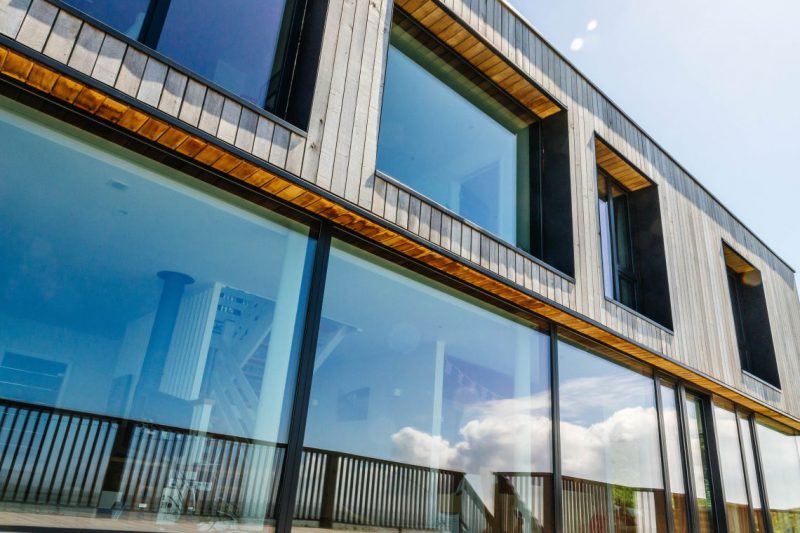How Does Triple Glazing Meet Energy Requirements?
4 September 2023
ecoHaus‘ triple glazing solutions have gained significant popularity in recent years due to the exceptional energy-saving capabilities and ability to meet strict energy requirements that it upholds.
As concerns about climate change and energy conservation continue to grow, homeowners are turning to triple glazing as an effective solution to reduce heat loss and increase energy efficiency in their property. In this article, ecoHaus will explore the benefits of triple glazing, the difference between double glazing and triple glazing, and how it helps meet energy requirements with less impact on the environment.
What is Triple Glazing? and How Does it Work?
Triple glazing is an advanced window glazing system. It consists of three layers of glass separated by insulating air gaps. Each glass pane is typically made of low-emissivity (low-E) glass which has a thin, transparent coating that helps improve energy efficiency and reduce carbon emissions.
The combination of multiple glass panes and insulating air gaps create a product with strong insulation capabilities. The gaps between each pane of coated glass are often filled with inert gases, such as argon, which has low thermal conductivity. The insulating gases help slow down the transfer of heat between the glass panes.
Enhanced Thermal Insulation
One of the primary advantages of ecoHaus triple glazing products is its superior thermal insulation properties. Unlike traditional double glazing, which consists of two panes of glass with a layer of air in between, triple glazing incorporates an additional pane of glass. This extra layer of glass creates two insulating air gaps, providing enhanced insulation against heat loss. This can be demonstrated perfectly by our Internorm triple glazed windows and doors. As a result of reducing thermal bridging and minimising heat transfer, triple glazing significantly improves the energy efficiency of buildings, resulting in reduced heating and cooling costs.

Meeting Energy Efficiency Standards
Triple glazing is designed to meet and exceed energy efficiency standards set by the regulatory body Ofgem in Britain. Triple glazing is an effective solution for achieving these standards with its remarkable insulating capabilities. The additional glass pane and insulating air gaps contribute to higher thermal resistance, helping buildings meet or exceed energy efficiency benchmarks.
Reducing Heat Loss with ecoHaus
Heat loss through windows and doors is a significant factor contributing to the energy inefficiency of a building. Triple glazing acts as a strong barrier. The multiple layers of glass and insulating air gaps minimise heat loss and improve overall thermal performance by creating a thermal barrier that prevents heat from escaping, ensuring a more comfortable indoor environment. By reducing heat loss, triple glazing allows for more efficient heating and reduces the reliance on heating systems, resulting in energy savings and lower utility bills.
Solar Heat Gain and Control
While triple glazing is highly effective in reducing heat loss, it also offers the benefits of solar heat gain and control. Solar heat gain refers to the heat gained from sunlight entering a building through windows. Triple glazing incorporates advanced coatings and low-emissivity (Low-E) glass that can selectively control solar heat gain. This means that during hot summer months, the glazing can minimise the amount of heat entering the building. This reduces the need for excessive air conditioning. On the contrary, during the cold season, the glazing can allow for more solar heat gain, assisting in passive heating.
Noise Reduction Capabilities
In addition to its incredible energy saving properties, ecoHaus triple glazing products also provides excellent sound insulation. The multiple layers of glass and insulating air gaps effectively dampen external noise, creating a quieter and more peaceful indoor environment. This is particularly beneficial for those living in noisy areas, such as near busy roads or urban environments. The enhanced sound insulation offered by triple glazing contributes to improved quality of life and increased comfort within the building.
So, what’s the Difference Between Double Glazing and Triple Glazing?
Double glazing and triple glazing are two different window glazing systems that vary in terms of the number of glass panes and insulating air gaps they incorporate.
While double glazing solutions have maintained a key role in home improvement, the addition of another glass pane and insulation air gap that triple glazing has creates a stronger thermal resistance and better control over solar heat gain. This results in better temperature management within the home and a lower environmental impact.
Triple glazing has emerged as a powerful solution to meet energy requirements and enhance energy efficiency in buildings. With its superior thermal insulation properties, ability to reduce heat loss, and control solar heat gain, triple glazing is crucial in reducing energy consumption and carbon emissions. By incorporating triple glazing products like our Visiline ALU6 Windows or Internorm Sliding Doors into buildings, homeowners and architects can achieve energy efficiency standards, lower heating and cooling costs, and create more comfortable living spaces. As the demand for sustainable and energy-efficient solutions continues to grow, triple glazing proves to be an effective choice for meeting energy requirements and promoting a greener future.




